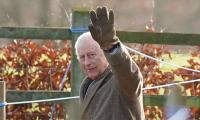In 1947, when Pakistan was created as an independent country, the new government asked the British Air Force command for pointing out the most experienced and trusted pilots who would be able to help establish the air force in Pakistan.
The British professionals recommended Polish officers, pilots and technicians, who had gained fame in the Battle of Britain. After the war, they were unable to return home, since it was under Soviet occupation. There was no place for them in the Royal Air Force either.
Nawabzada Liaquat Ali Khan, the Prime Minister of Pakistan, who also had the portfolio of the Defence Minister, did not hesitate in accepting the British recommendation and offered them three-year contracts with high salaries. 30 Polish officers chose to join the Royal Pakistan Air Force (RPAF) as it was known then. (‘Royal’ was dropped on 23 March 1956 when Pakistan became a Republic). Thus, a small group of 30 Polish pilots, engineers and technicians led by Turowicz arrived in Pakistan in 1947.
RPAF made a humble beginning with two fighter and one transport squadrons, a negligible infrastructure, non-existent command structure, and almost nil maintenance facilities.
Within three weeks of independence, Indian hegemonic designs sparked off the first war between Pakistan and India. Pakistan’s young air arm was called upon to fly supply missions with one of the two war-weary Dakotas. Contending with the unpredictable weather, the difficult terrain, and the enemy fighters was an uphill task. The strength was replenished with two more Dakotas only as the skirmishes resumed the following winters.
It was in this milieu that Squadron Leader Wladyslaw Józef Marian Turowicz, who was only 39 years of age, together with his wife Zofia, and the Polish air and ground crew, set about helping establish RPAF. Turowicz and his team set up technical institutes in Karachi. He taught and revitalized the PAF Academy, where he worked as a chief scientist. His colleagues assisted him in imparting specialized technical training to RPAF technicians.
Zofia, Turowicz’s wife, also contributed to the PAF in her own way. She taught gliding to Shaheen Air Cadets in Karachi and Rawalpindi, and applied mathematics and particle physics at Karachi University.
In 1952, Turowicz was promoted to the rank of Wing Commander, in 1959, to the rank of Group Captain, and in 1960 he became an Air Commodore and an Assistant Chief of Air Staff in charge of PAF’s Maintenance Branch.
In 1965, the first major Indo-Pak War broke out. As veterans of World War II, Turowicz and his fellow Poles had sufficient experience in aerial combat. They flew the legendary F-86 Sabres and joined their Pakistani comrades in defending Lahore’s skies against the invading Indian planes. After the war ended, Turowicz and his colleagues were hailed as national heroes in Pakistan. Along with his comrade Squadron Leader Anotnii Zbigniew Jedryszek, Air Commodore Turowicz and other Polish pilots were awarded the Sitara-e-Pakistan. During a grand ceremony in Pakistan’s new capital Islamabad, then President (Field Marshal) Ayub Khan granted honorary citizenships to these Polish officers for their bravery and sincerity in helping Pakistan in its hour of need.
Turowicz was killed in a car crash on January 8, 1980. He was buried with full military honours. For his meritorious service, Turowicz was honoured with many awards including the Sitara-i-Pakistan, the Tamgha-i-Pakistan, the Sitara-i-Khidmat, the Sitara-i-Quaid-i-Azam, the Sitara-i-Imtiaz, the Abdus Salam Award in Aeronautical Engineering and the ICTP Award in Space Physics. The Pakistan Air Force placed a memorial in honour of Air Commodore Turowicz at the PAF Museum while Suparco established the Wladyslaw Turowicz Space Complex in Lahore.
While the Polish pilots rendered yeoman services to the RPAF and later PAF fighter command and the technical services, some pilots and technicians joined the air transport command of the fledgling air force. Squadron Leader Wolanski commanded the prestigious No 6 Squadron, which is one of the oldest air force squadrons of the Subcontinent.
Squadron Leader Wolanski’s command extended from December 1948 to March 1949. Every Pakistani pilot knows him and his achievements. He supervised extensive and very daring night drop missions in the beleaguered Kashmir Valley using the intrepid but outdated Douglas Dakota DC-3 aircraft. Most of the sorties were conducted through the hubs of Risalpur and Peshawar. Under Squadron Leader Wolanski’s auspicious command, 437 air drop sorties were conducted at the challenging Bunji, Astor, Gilgit, Burzal and Skardu drop zones.
During his command, the Prime Minister and Defence Minister Nawabzada Liaquat Ali Khan visited the squadron and lauded its services to the nation, especially under the command of Squadron Leader Wolanski.
It is also a historic landmark that during the tenure of command of Squadron Leader Wolanski, Gilgit airfield was completed on 22 February 1949 and the bold Polish Squadron Commander landed the first aircraft on the tricky Gilgit airfield, which still remains treacherous and has claimed a number of aircraft accidents during landing.
The Polish contribution to Pakistan Air Force is a matter of pride for the rank and file of this fighting force and speaks volumes for the bravery and enterprising skills of the pioneering Polish officers and men, who helped establish PAF.
Due to breakdown, power was cut off in Mall Road, Jhikagali, Bhurban, Expressway and other areas
Demonstrators criticise introduction of a token system at the Kuntani border
He says bunkers would be demolished and weapons collected to restore peace to the area
Special Judge Central Shahrukh Arjumand conducts hearing at Adiala Jail on Friday
PN flotilla was led by Commander 14th Destroyer Squadron, Commodore Muhammad Umair
ATC Special Judge Amjad Ali Shah approves her bail until January 13







